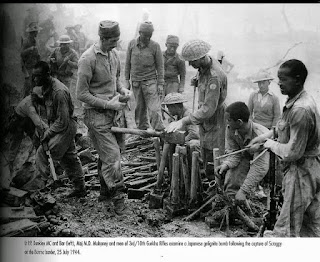 | |
"Gorkhas of North-East Blogging"Lighting Gorkhalism |
 |
'Kafir hunu bhanda marnu jati" |
If a man says he is not afraid of dying, he is either lying or is a Gurkha.
The British had identified the Gorkhas as a 'martial race' for their sterling qualities of toughness and fortitude. The Gorkha soldier is famous the world over for his ferocity and unflinching courage in battle. One author has described the Gorkhas as "small of stature, large of heart, accustomed to hardship, good-natured with a keen sense of humour, loyal to death, more disciplined than any fighting force in the world, brave and capable and absolutely without fear." These hardy troops are undoubtedly tough, bold and durable under withering fire, and they are extremely well-disciplined . Close family ties within each battalion ensure that they fight not only for the paltan'sizzatbut also for their own kith and kin. 'Kafir hunu bhanda marnu jati' (better to die than be a coward' ) is the motto of the Gorkha soldiers who continue to serve in the British, Indian and Nepalese armies with pride and professionalism of a very high order.
The Gorkha regiments of the British Indian Army played a key role during both the World Wars. They saw action in Africa, Europe and in Asia and earned battle honours everywhere. Following Partition in 1947, under a tripartite agreement between Britain, India and Nepal, four Gorkha regiments —2 , 6, 7and 10regiments —were transferred to the British Army, eventually becoming the Gorkha Brigade. Of the total of 10 regiments, six (1, 3, 4, 5, 8and 9regiments) joined the Indian Army. 11 GR was raised later. Currently there are 39 battalions serving in seven Gorkha regiments in the Indian Army. While Gorkhas in the Indian Army hail both from Nepal and India's hill regions, the Nepalese Gorkhas have helped to build strong bonds of friendship between the two armies.
Though all the Gorkha regiments have performed creditably in India's wars since independence, the 5Gorkha Rifles has a legendary record. The 5/5 GR (FF) fought gallantly in the Hyderabad Police Action in 1948. In this action, Naik Nar Bahadur Thapa was awarded the first Ashok Chakra Class I of independent India on September 15, 1948. The 4/5 GR (FF) earned the distinction of becoming the first battalion of the Indian Army to participate in a heliborne attack in the Battle of Sylhet during the 1971 war for the liberation of Bangladesh. Besides the major wars, the Gorkhas have served in Bangladesh, Sri Lanka, at the Siachen Glacier and in the UN peacekeeping missions in Lebanon and Sierra Leone . In October 2011, the 4/9 GR won the gold medal in the annual Cambrian Patrol Competition held in Wales, UK.
The Gorkhas still carry into battle their traditional weapon —an 18-inch long wickedly curved, broadbladed heavy knife known as the khukri. It is the world's most renowned fighting knife. It's said: "Often the mere sight of an unsheathed khukri is enough to discourage any further action by causing a cold, cramped feeling in the nether regions of the stomach." Legend has it that once a khukri was drawn in battle , it had to 'taste blood' . If it did not, its owner had to cut himself before returning it to its sheath.
"Some of the "Vintage Photos" of Gurkha Rifles.



































No comments:
Post a Comment